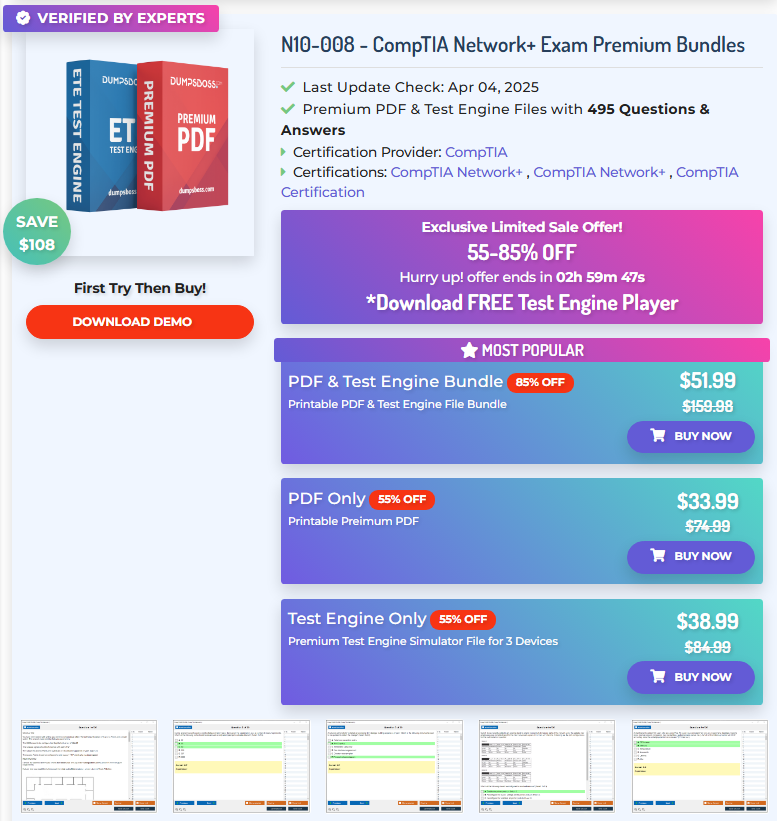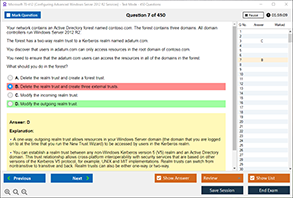Overview of the CompTIA N10-008 Exam
The CompTIA Network+ (N10-008) is a globally recognized certification that validates the essential skills needed to design, configure, manage, and troubleshoot wired and wireless networks. The N10-008 exam covers several domains, including:
-
Networking fundamentals
-
Network implementations
-
Network operations
-
Network security
-
Network troubleshooting
Among these, network operations and troubleshooting focus heavily on network monitoring, a fundamental skill for network administrators.
Key Details:
-
Exam Code: N10-008
-
Number of Questions: Up to 90
-
Types of Questions: Multiple choice and performance-based
-
Passing Score: 720 (on a scale of 100-900)
-
Recommended Experience: CompTIA A+ Certification and 9-12 months of networking experience
Let’s take a deep dive into network monitoring, a concept that appears consistently in CompTIA’s objectives.
Definition of Network Monitoring
Network monitoring refers to the continuous observation and management of a computer network to ensure its optimal performance, availability, and security. It involves collecting real-time data from devices like routers, switches, firewalls, and servers to detect and troubleshoot problems.
Key goals of network monitoring include:
-
Detecting outages or performance bottlenecks
-
Ensuring optimal bandwidth utilization
-
Identifying unauthorized access or security threats
-
Diagnosing device failures before they become critical
The N10-008 exam assesses your knowledge of how different monitoring protocols work and how they’re implemented in real-world scenarios.
Commonly Used Protocols for Network Monitoring
Let’s review the most commonly tested and widely used network monitoring protocols that appear in the CompTIA N10-008 exam.
1. SNMP (Simple Network Management Protocol)
SNMP is one of the most important monitoring protocols for managing devices on IP networks. It allows administrators to query network devices and receive alerts (traps) about performance metrics, configurations, and faults.
SNMP Features:
-
Operates over UDP (ports 161 and 162)
-
Supports multiple versions (v1, v2c, v3)
-
Uses MIBs (Management Information Bases) to define device metrics
-
Enables both polling (pull) and trap-based (push) communication
SNMP Exam Tips:
-
Know the difference between SNMP v1, v2c, and v3 (v3 is secure with authentication and encryption)
-
Understand how SNMP agents and managers interact
-
Be able to troubleshoot SNMP communication issues
2. NetFlow
NetFlow, developed by Cisco, is a protocol used to collect and analyze IP traffic information for network monitoring and traffic analysis.
NetFlow Features:
-
Captures detailed flow data including IP addresses, ports, protocols, and traffic volumes
-
Useful for capacity planning, trend analysis, and intrusion detection
-
Often used in conjunction with tools like SolarWinds, ntop, or PRTG
NetFlow Exam Tips:
-
Understand the concept of network flows (a flow is a unidirectional series of packets with shared characteristics)
-
Know how NetFlow helps identify top talkers and top applications on a network
3. Syslog
Syslog is a protocol used for sending system log or event messages to a centralized server, known as a Syslog server.
Syslog Features:
-
Works over UDP port 514
-
Supports standardized log levels (e.g., Emergency, Alert, Critical, etc.)
-
Useful for auditing, security monitoring, and event correlation
Syslog Exam Tips:
-
Be familiar with Syslog severity levels (0–7, from Emergency to Debug)
-
Know how to set up log retention and configure devices to send logs to a server
-
Expect questions involving interpreting logs or identifying misconfigurations
4. ICMP (Internet Control Message Protocol)
ICMP is widely used for diagnostics and network testing. It is the protocol behind tools like ping and traceroute.
ICMP Features:
-
Operates at the Network Layer (Layer 3)
-
Used to send error messages and operational information
-
Crucial for identifying network path issues and unreachable destinations
ICMP Exam Tips:
-
Know how ping and traceroute work and what their outputs indicate
-
Understand the limitations of ICMP (it can be blocked or rate-limited by firewalls)
-
Familiarity with ICMP message types (e.g., Echo Request, Echo Reply)
Additional Monitoring Protocols (Mentioned in Exam)
While SNMP, NetFlow, Syslog, and ICMP are essential, the N10-008 exam may also touch on other monitoring-related protocols and tools, including:
RMON (Remote Monitoring)
-
Extension of SNMP that enables monitoring of network segments
-
Offers statistics collection and alert generation
NTP (Network Time Protocol)
-
Ensures time synchronization across network devices
-
Important for log correlation and network event auditing
WMI (Windows Management Instrumentation)
-
Microsoft’s protocol for managing and monitoring Windows-based devices
-
Often used with tools like Nagios, Zabbix, or Microsoft SCOM
Packet Capture Tools
-
Tools like Wireshark, tcpdump, or TShark are essential for analyzing packet-level data
-
Can help diagnose deep protocol-level issues and security breaches
Tips for Answering Network Monitoring Questions in N10-008
The CompTIA Network+ exam often uses scenario-based questions that test practical application of your knowledge. Here are tips to tackle network monitoring questions effectively:
1. Look for Keywords in the Scenario
Pay attention to terms like “SNMP trap,” “ping timeout,” “Syslog error,” or “NetFlow capture.” These hint at the correct monitoring protocol or tool.
2. Match the Problem to the Right Tool
-
Ping fails? Think ICMP
-
Traffic spike? Consider NetFlow
-
Authentication issues? Check Syslog or SNMP v3
-
Slow device response? Use SNMP to check utilization or logs
3. Eliminate Wrong Choices
Many options might sound right but only one will logically solve the issue in question. Use the process of elimination, especially when two answers seem similar.
How to Study Network Monitoring Topics Effectively
Preparing for network monitoring topics in the N10-008 exam doesn’t have to be overwhelming. Here's how DumpsBoss recommends you approach your studies:
1. Use Realistic Practice Questions
Practicing with verified dumps and mock exams from DumpsBoss ensures you are exposed to real-world scenarios and question styles. These resources reinforce key concepts and improve retention.
2. Lab Exercises and Simulations
Hands-on labs using Wireshark, SNMP simulators, or GNS3 will give you practical experience with monitoring protocols. Simulations help bridge the gap between theory and implementation.
3. Focused Note-Taking
Create flashcards or summary sheets for key protocol features, port numbers, and use cases. For instance:
-
SNMP – UDP 161/162
-
Syslog – UDP 514
-
ICMP – No port (part of IP)
-
NetFlow – Port varies (usually UDP 2055, 9996, or 4739)
4. Watch Video Tutorials
Platforms like YouTube or ITProTV provide visual walkthroughs of protocols in action, making it easier to understand abstract concepts.
5. Join Forums and Study Groups
Engage in communities like DumpsBoss and DumpsArena to discuss tricky questions and learn from others.
Conclusion
Mastering network monitoring protocols is essential not just for passing the CompTIA N10-008 exam but also for becoming an effective network administrator. SNMP, NetFlow, Syslog, and ICMP are foundational to any IT professional’s toolkit and appear frequently on the exam.
At DumpsBoss, we provide expert-verified exam dumps, practice tests, and comprehensive guides that align closely with the exam objectives. By combining hands-on practice, a solid understanding of key protocols, and our high-quality study materials, you can pass the N10-008 exam with confidence.
Get ahead in your IT career—start preparing with DumpsBoss today and turn your certification goals into reality!
Special Discount: Offer Valid For Limited Time “N10-008 Exam” Order Now!
Sample Questions for CompTIA N10-008 Dumps
Actual exam question from CompTIA N10-008 Exam.
Which protocol can be used to monitor the network?
A) FTP
B) SNMP
C) SMTP
D) DHCP



